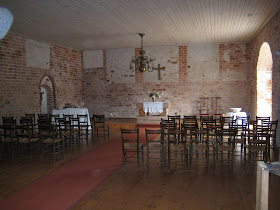





 Bäckaskog Castle is best known as the summer residence of King Carl XV of Sweden and Norway. Situated on a narrow strip of land between the lakes Ivosjön and Oppmannasjön near Kristianstad in the province of Scania, the castle started out as a monastery and is now a hotel.
Bäckaskog Castle is best known as the summer residence of King Carl XV of Sweden and Norway. Situated on a narrow strip of land between the lakes Ivosjön and Oppmannasjön near Kristianstad in the province of Scania, the castle started out as a monastery and is now a hotel.The monastery was founded in the 1220s and the church (seen in the third and fourth photos) and the kitchen are the oldest parts to have survived. This was when Scania was Danish and following the reformation in 1537, Bäckaskog was confiscated by the Danish Crown. In 1584 the Crown exchanged Bäckaskog with other estates belonging to Henrik Ramel, the future Christian IV’s governor. Ramel built the castle as we know it today, with four wings enclosing a courtyard. Bäckaskog is quite unique in having kept its 16th century appearance up until our time.
In 1664, after Scania had been ceded to Sweden, Ove Ramel the Younger swore allegiance to the Swedish King and was incorporated into the Swedish nobility. But it was not long before he changed his mind and in 1680 Bäckaskog was confiscated by the Swedish Crown.
Between 1696 and 1818 Bäckaskog was the official residence of the colonel of the Southern Scanian Cavalry Regiment. The last military man to reside at Bäckaskog was Field Marshal Johan Christopher Toll, who lived there 1782-1797 and 1798-1817. King Gustaf IV Adolf was a frequent visitor and it was at Bäckaskog on 3 October 1905 that the treaty with Britain, whereby Sweden joined the Third Coalition against France, was signed. This was a decision which in 1809 led to the loss of Finland and the fall of Gustaf IV Adolf.
The Napoleonic Wars brought a new dynasty, the Bernadottes, to Sweden and in 1819 Bäckaskog was put at the disposal of Crown Prince Oscar. He rarely came there, but the west wing was rebuilt to house modern accommodations for the royal family and their court. In 1845, a year after he had succeeded to the throne as Oscar I, he ceded the right to use Bäckaskog to his oldest son, Crown Prince Carl. The Crown Prince was also Duke of Scania and came to stay at Bäckaskog every summer, also after he became King Carl XV in 1859. He was very popular with the locals and did not hesitate to take part in their festivities.
Today the royal apartments are filled with period furniture, but not all of it is original. The King’s portrait (said to be a self-portrait) hangs over his bed (sixth photo) and above a sofa in the drawing room (fifth picture) is one of the many landscapes painted by Carl XV himself.
Carl XV greatly improved the agricultural business at Bäckaskog and had the park remodelled in the fashion of a landscape park. It was under the tree seen in the last picture that Crown Prince Frederik of Denmark in 1868 proposed to Carl XV’s only surviving child, Princess Lovisa. When Carl XV died prematurely four years later, it was they who took over the lease of Bäckaskog. But they did not go there much, the place fell into disrepair and in 1900 they renounced their right of disposal.
That was also the end of Bäckaskog’s royal epoch. Since 1956 it has been a conference hotel, with guided tours of the royal apartments and park taking place on certain days in summer. Earlier this year, the Swedish Property Board resolved that Bäckaskog was not considered of great historical value and may therefore be sold by the state.
No comments:
Post a Comment
Comments are welcome, but should be signed - preferably by a name, but an initial or a nick will also be accepted. Advertisements are not allowed. COMMENTS WHICH DO NOT COMPLY WITH THESE RULES WILL NOT BE PUBLISHED.